Abstract
Many drugs or chemicals had markedly different effects on the cytotoxicity induced by Pseudomonas aeruginosa exotoxin A (PE) or Corynebacterium diphtheriae exotoxin (DE). The glycolytic inhibitor NaF protected cells from DE but potentiated the cytotoxicity of PE. Another energy inhibitor, salicylic acid, also protected cells from DE but had no effect with PE. Colchicine and colcemid did not affect the cytotoxicity of either toxin. Cytochalasin B exhibited a modest protection from DE but no effect with PE. Ouabain, a specific inhibitor of the Na+, K+-dependent adenosine 5'-triphosphatase (ATPase), did not affect the cytotoxicity of either toxin. Ruthenium red, a specific inhibitor of the Ca2+, Mg2+,-dependent ATPase, conferred marked protection from DE-induced cytotoxicity but did not affect PE-induced cytotoxicity. A number of local anesthetics were tested, and they too presented differential results with PE and DE. Most chemicals that affected toxin-induced cytotoxicity had little or no influence on the in vitro adenosine 5'-diphosphate-ribosylation catalyzed by either toxin. This work presents further evidence that PE and DE have different mechanisms of intoxication and suggests that these differences lie in the attachment or internalization stages of intoxication.
Full text
PDF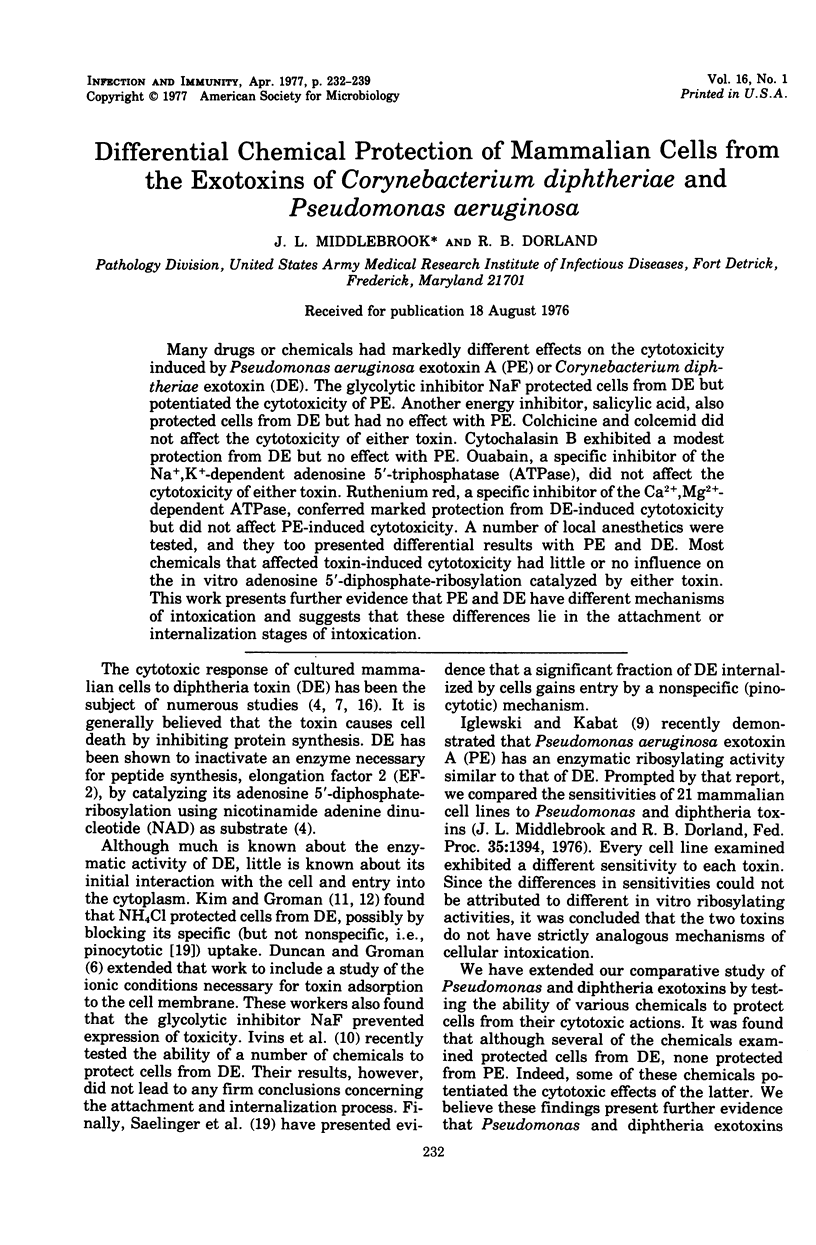

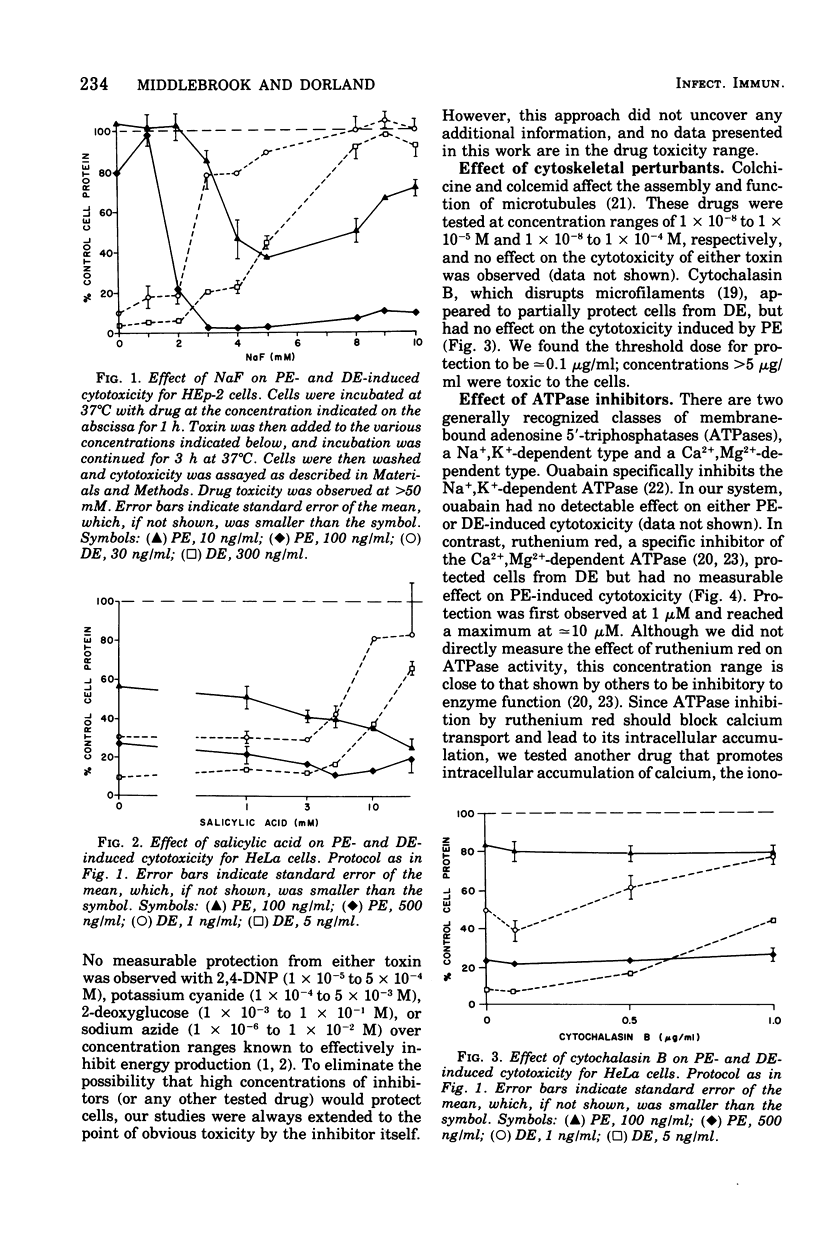
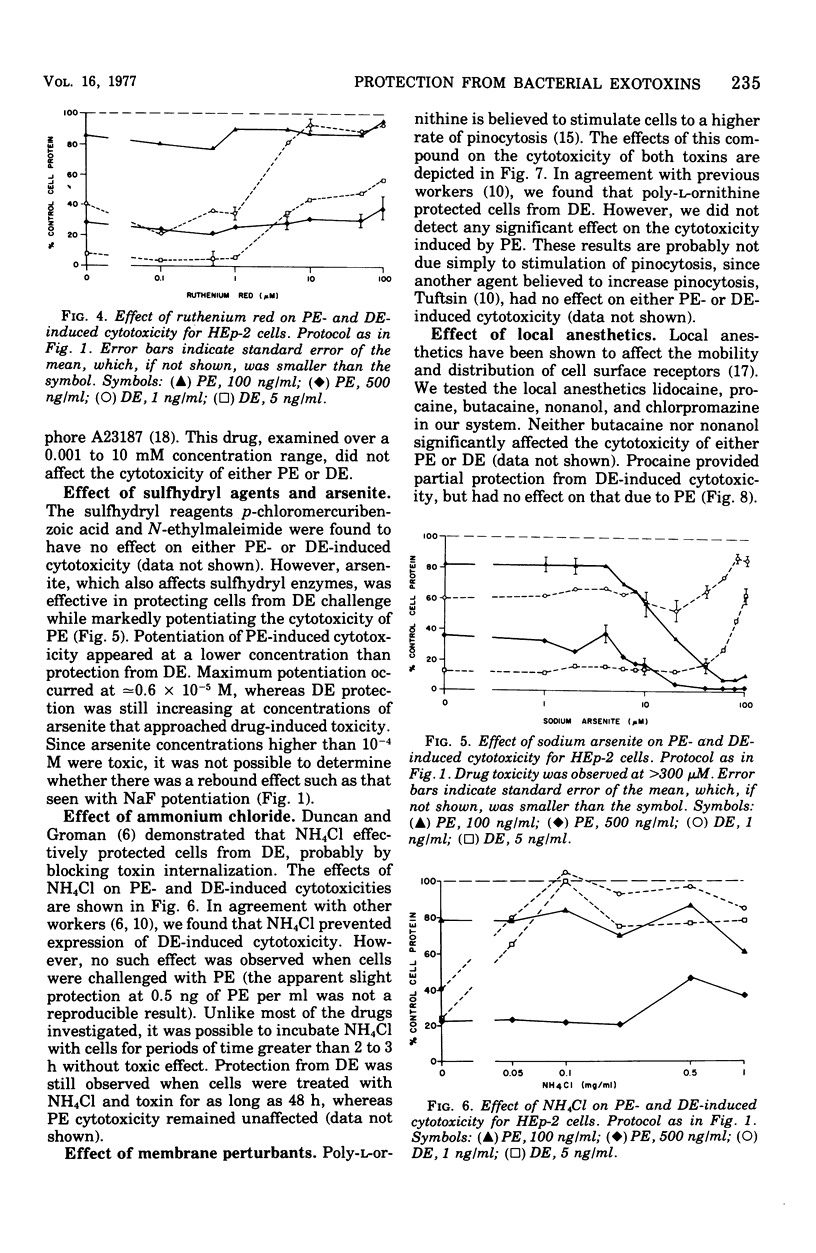

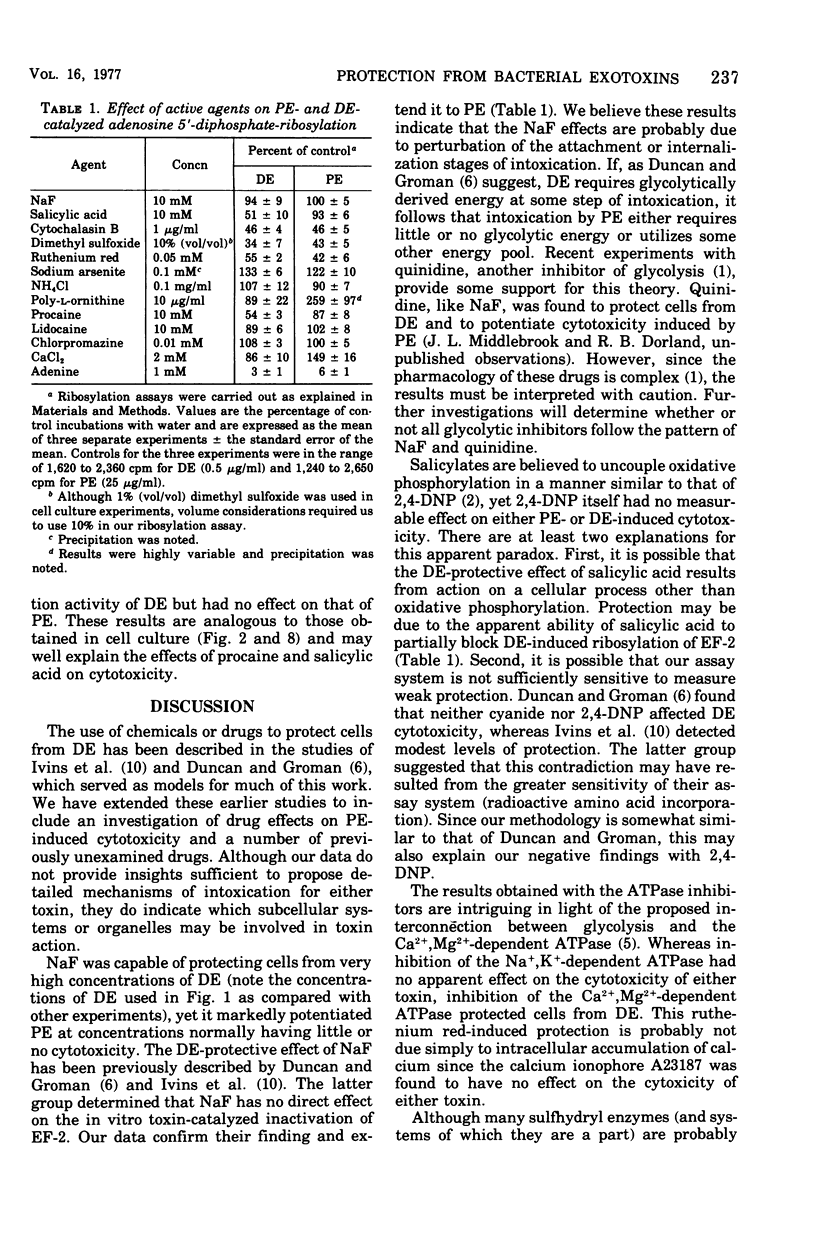
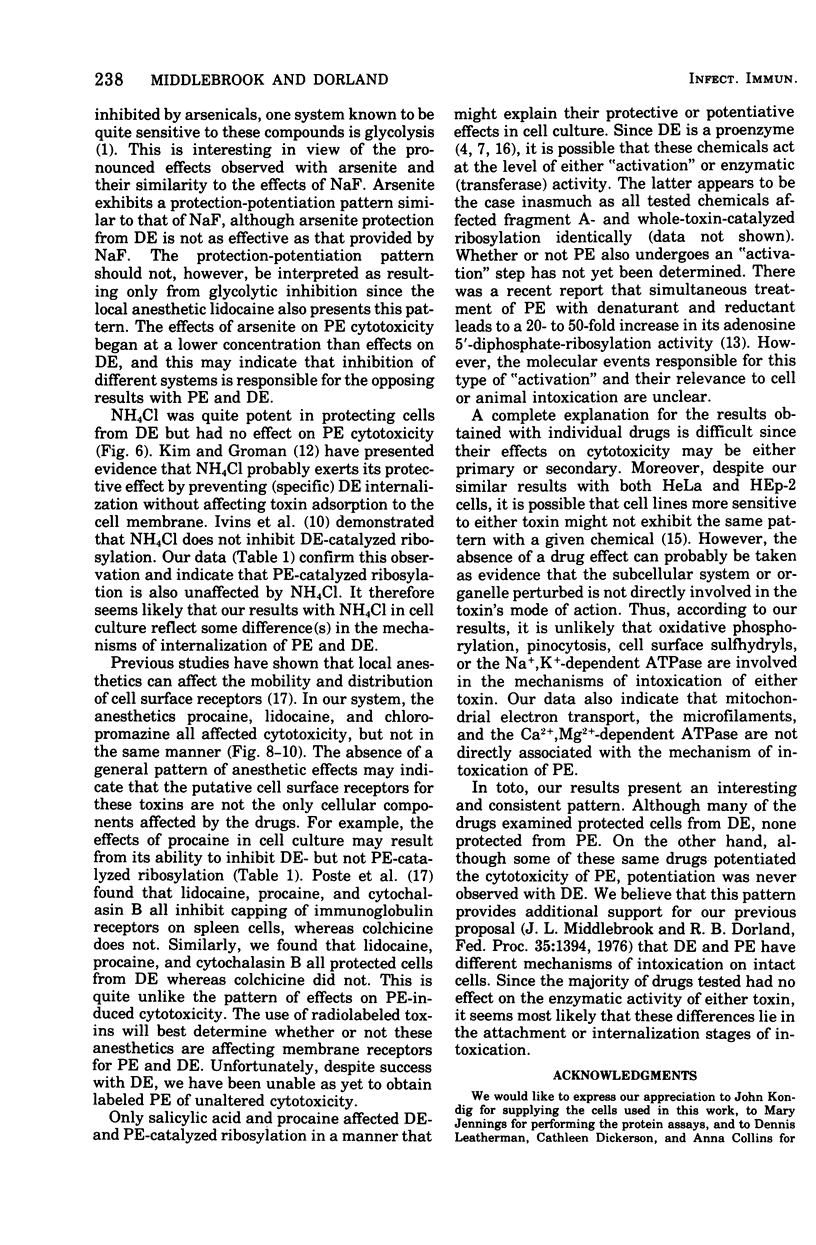
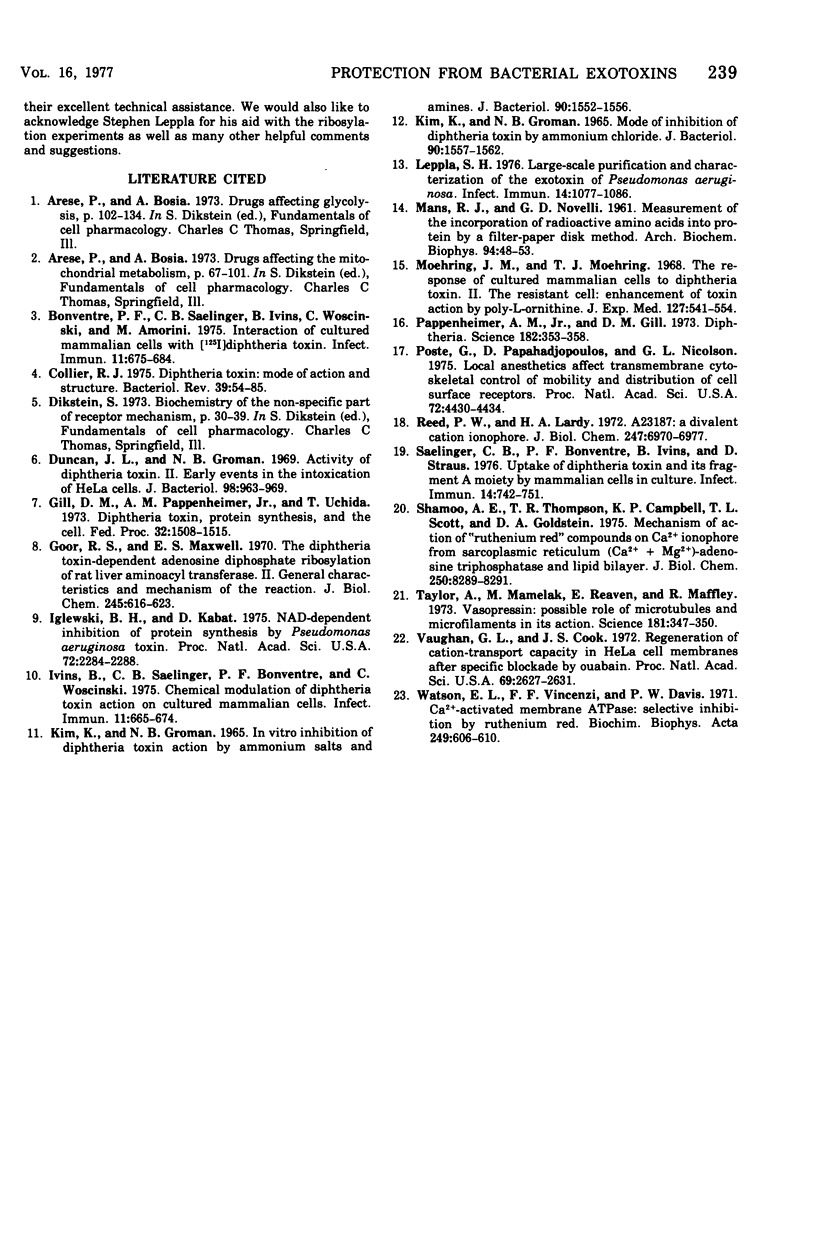
Selected References
These references are in PubMed. This may not be the complete list of references from this article.
- Bonventre P. F., Saelinger C. B., Ivins B., Woscinski C., Amorini M. Interaction of cultured mammalian cells with [125I] diphtheria toxin. Infect Immun. 1975 Apr;11(4):675–684. doi: 10.1128/iai.11.4.675-684.1975. [DOI] [PMC free article] [PubMed] [Google Scholar]
- Collier R. J. Diphtheria toxin: mode of action and structure. Bacteriol Rev. 1975 Mar;39(1):54–85. doi: 10.1128/br.39.1.54-85.1975. [DOI] [PMC free article] [PubMed] [Google Scholar]
- Duncan J. L., Groman N. B. Activity of diphtheria toxin. II. Early events in the intoxication of HeLa cells. J Bacteriol. 1969 Jun;98(3):963–969. doi: 10.1128/jb.98.3.963-969.1969. [DOI] [PMC free article] [PubMed] [Google Scholar]
- Gill D. M., Pappenheimer A. M., Jr, Uchida T. Diphtheria toxin, protein synthesis, and the cell. Fed Proc. 1973 Apr;32(4):1508–1515. [PubMed] [Google Scholar]
- Goor R. S., Maxwell E. S. The diphtheria toxin-dependent adenosine diphosphate ribosylation of rat liver aminoacyl transferase. II. General characteristics and mechanism of the reaction. J Biol Chem. 1970 Feb 10;245(3):616–623. [PubMed] [Google Scholar]
- Iglewski B. H., Kabat D. NAD-dependent inhibition of protein synthesis by Pseudomonas aeruginosa toxin,. Proc Natl Acad Sci U S A. 1975 Jun;72(6):2284–2288. doi: 10.1073/pnas.72.6.2284. [DOI] [PMC free article] [PubMed] [Google Scholar]
- Ivins B., Saelinger C. B., Bonventre P. F., Woscinski C. Chemical modulation of diphtheria toxin action on cultured mammalian cells. Infect Immun. 1975 Apr;11(4):665–674. doi: 10.1128/iai.11.4.665-674.1975. [DOI] [PMC free article] [PubMed] [Google Scholar]
- Kim K., Groman N. B. In vitro inhibition of diphtheria toxin action by ammonium salts and amines. J Bacteriol. 1965 Dec;90(6):1552–1556. doi: 10.1128/jb.90.6.1552-1556.1965. [DOI] [PMC free article] [PubMed] [Google Scholar]
- Kim K., Groman N. B. Mode of inhibition of diphtheria toxin by ammonium chloride. J Bacteriol. 1965 Dec;90(6):1557–1562. doi: 10.1128/jb.90.6.1557-1562.1965. [DOI] [PMC free article] [PubMed] [Google Scholar]
- Leppla S. H. Large-scale purification and characterization of the exotoxin of Pseudomonas aeruginosa. Infect Immun. 1976 Oct;14(4):1077–1086. doi: 10.1128/iai.14.4.1077-1086.1976. [DOI] [PMC free article] [PubMed] [Google Scholar]
- Moehring J. M., Moehring T. J. The response of cultured mammalian cells to diphtheria toxin. II. The resistant cell: enhancement of toxin action by poly-L-ornithine. J Exp Med. 1968 Mar 1;127(3):541–554. doi: 10.1084/jem.127.3.541. [DOI] [PMC free article] [PubMed] [Google Scholar]
- Pappenheimer A. M., Jr, Gill D. M. Diphtheria. Science. 1973 Oct 26;182(4110):353–358. doi: 10.1126/science.182.4110.353. [DOI] [PubMed] [Google Scholar]
- Poste G., Papahadjopoulos D., Nicolson G. L. Local anesthetics affect transmembrane cytoskeletal control of mobility and distribution of cell surface receptors. Proc Natl Acad Sci U S A. 1975 Nov;72(11):4430–4434. doi: 10.1073/pnas.72.11.4430. [DOI] [PMC free article] [PubMed] [Google Scholar]
- Reed P. W., Lardy H. A. A23187: a divalent cation ionophore. J Biol Chem. 1972 Nov 10;247(21):6970–6977. [PubMed] [Google Scholar]
- Saelinger C. B., Bonventre P. F., Ivins B., Straus D. Uptake of diphtheria toxin and its fragment A moiety by mammalian cells in culture. Infect Immun. 1976 Sep;14(3):742–751. doi: 10.1128/iai.14.3.742-751.1976. [DOI] [PMC free article] [PubMed] [Google Scholar]
- Shamoo A. E., Thompson T. R., Campbell K. P., Scott T. L., Goldstein D. A. Mechanism of action of "ruthenium red" compounds on Ca2+ ionophore from sarcoplasmic reticulum (Ca2+ + Mg2+)- adenosine triphosphatase and lipid bilayer. J Biol Chem. 1975 Oct 25;250(20):8289–8291. [PubMed] [Google Scholar]
- Taylor A., Mamelak M., Reaven E., Maffly R. Vasopressin: possible role of microtubules and microfilaments in its action. Science. 1973 Jul 27;181(4097):347–350. doi: 10.1126/science.181.4097.347. [DOI] [PubMed] [Google Scholar]
- Vaughan G. L., Cook J. S. Regeneration of cation-transport capacity in HeLa cell membranes after specific blockade by ouabain. Proc Natl Acad Sci U S A. 1972 Sep;69(9):2627–2631. doi: 10.1073/pnas.69.9.2627. [DOI] [PMC free article] [PubMed] [Google Scholar]
- Watson E. L., Vincenzi F. F., Davis P. W. Ca 2+ -activated membrane ATPase: selective inhibition by ruthenium red. Biochim Biophys Acta. 1971 Dec 3;249(2):606–610. doi: 10.1016/0005-2736(71)90140-4. [DOI] [PubMed] [Google Scholar]


